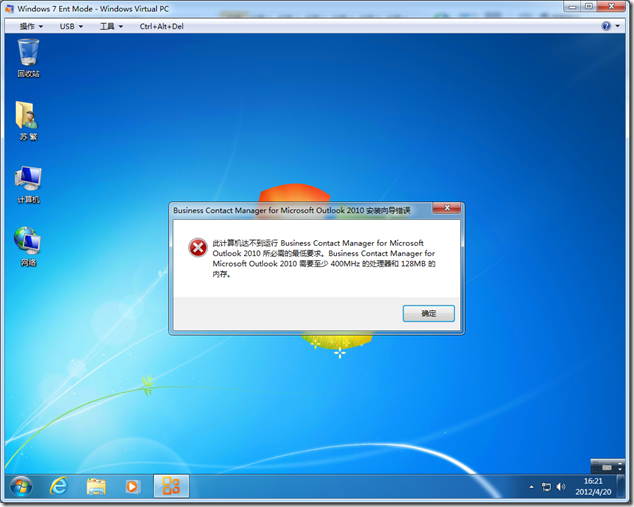本站域名:http://goxia.maytide.net or http://sufan.maytide.net
 移动设备请访问:http://goxia.maytide.net/m
移动设备请访问:http://goxia.maytide.net/m转载文章,请务必保留出处与作者信息,未经许可严禁用于商业用途!
[WS2012]HOWTO: 解决 Windows Server 2012 Hyper-V 实时迁移时遇到的 0x80090303 故障
HOWTO: 解决 Windows Server 2012 Hyper-V 实时迁移时遇到的 0x80090303 故障
当我们在测试 Windows Server 2012 Hyper-V 实时迁移(如:无需共享存储的实时迁移)过程中可能会遇到 0x80090303 故障,错误如下图所示:
具体内容大致为“迁移源上的虚拟机迁移操作失败。无法验证源主机上的连接:指定的目标未知或无法达到(0x80090303)。”由于 0x80090303 故障与之前日志中提到的 0x8009030E 故障极为相似,如果不加注意我们便会按照实时迁移时 kerberos 权限委派的步骤进行排错解决,去为主机委派设置添加“Microsoft Virtual System Migration Service”服务类型。gOxiA 当初就走入了这个误区,当使用 ADUC 为 Hyper-V 主机去做委派时发现在主机委派服务类型中并未找到“Microsoft Virtual System Migration Service”。
检查 Hyper-V 主机事件日志发现在“应用程序和服务日志”-“Microsoft”-“Windows”-“Hyper-V-VMMS”-“Admin”下记录有错误的事件ID:14050,来源为:Hyper-V-VMMS。具体内容是“无法注册服务主体名称“Microsoft Virtual System Migration Service”。”
此外,还包含其他几个相关的 SPN(服务主体名称)错误日志:“Hyper-V Replica Service”、“Microsoft Virtual Console Service”。之后使用 setspn –l hostname 进行检查,发现当前主机确实缺少这些 SPN,而“Microsoft Virtual System Migration Service”是我们迁移虚机所必须的。
那么什么是 SPN 呢?!引用一篇微软官方 Blog 的解释:SPN 即“服务主体名称”,是一种名称,唯一标识一个服务实例。用来验证 Kerberos 身份验证的 SPN 的必须正确设置。SPN 是 Active Birectory 属性,但不暴露在 AD 的管理单元。那么 SPN 的作用是什么呢?!gOxiA 推荐这篇微软 Blog http://blogs.technet.com/b/crmchina/archive/2010/01/29/crm-spn.aspx 供大家参考,虽然与 Hyper-V 没有直接关系,但他们之间的概念是相通的,便于我们更好的理解该故障发生的原因。
要解决该实时迁移过程中遇到的 0x80090303 故障,我们只需要手工在 Hyper-V 主机上对“Microsoft Virtual System Migration Service”进行 SPN 注册即可。为此,我们需要用到 setspn –s spnname/hostname(and FQDN) NetBIOSName 命令行,参考命令行如下:
完成“Microsoft Virtual System Migration Service”的 SPN 注册后,我们便可以正常执行实时迁移,0x80090303 故障消失!按理说 SPN 的注册应该是自动的,但是为什么在 gOxiA 的实验环境下出现失败注册,可能跟 DC 是 SBS2011 有关,因为网上能找到类似的故障都是使用的 SBS2011 作为域控。当然也不排除其他可能存在的因素,在微软的 KB2761899 中就提及到了这个事件 ID,如果你也遇到这个问题,并排除 SBS2011 的原因,那么可以参考:http://support.microsoft.com/kb/2761899?wa=wsignin1.0 解决!
关于 SPN 自动注册失败的原因及解决办法,gOxiA 会继续关注,一有答案便会跟大家分享!目前的办法只有使用 setspn 命令手工注册来解决!
[WS8] 微软发布 Windows Server 8 Beta Virtual Labs
微软发布 Windows Server“8”Beta Virtual Labs
关注 Windows Server“8”Beta(已经被证实命名为:Windows Server 2012)的同学们有福了,微软近日在 TechNet 网站上发布了一些列关于 Windows Server“8”Beta 的在线动手实验,内容非常丰富!如果目前你还未有测试环境,那么现在就可以免费使用微软提供的虚拟实验室了,每个实验提供了一份手册和长达90分钟的测试使用。在开始之前建议大家先阅读一下系统要求。
目前 Windows Server“8”Beta Virtual Labs 提供了如下相关的动手实验:
- Active Directory Deployment and Management Enhancements
In this lab, you will learn how to deploy Active Directory Domain Controllers with Windows Server "8". You will deploy domain controllers using the new Server Manager, as well as deploying remote domain controllers using Windows PowerShell. You will be able to explore the new Active Directory Management tool and use its PowerShell History Viewer. - Configuring a Highly Available iSCSI Target
In this lab, you will learn how Windows Server "8" can provide storage remotely to any machine. You will build clusters using shared storage and build iSCSI high-availability instances--observing highly available application communication during cluster failover. - Configuring Hyper-V over Highly Available SMB Storage
In this lab, you will learn how to configure a file server cluster to support running Hyper-V virtual machines from SMB file shares. You will create the file share, configure delegation, and then create a new VM on SMB storage. - Implementing Storage Pools and Storage Spaces
In this lab, you will work with the new storage spaces technology in Windows Server "8". You will first create new storage pools and virtual disks, and then you will work with those virtual disks in both Server Manager and Control Panel. - Introduction to Windows PowerShell Fundamentals
Windows PowerShell is a command-line shell and scripting language that helps you achieve greater control and productivity. Using a new admin-focused scripting language, more than 230 standard command-line tools, and consistent syntax and utilities, Windows PowerShell enables you to more easily control system administration and accelerate automation. - What’s New in Windows PowerShell 3.0
In this lab, you will explore some of the new features and functionality in Windows PowerShell 3.0 to enable you to more easily control system administration and accelerate automation. - Managing Branch Offices
In this lab, you will learn how the branch office scenario has been improved in Windows Server "8" including new branch cache enhancements. - Managing Network Infrastructure
In this lab, you will explore new network management capabilities in Windows Server "8". You will learn how to implement Network Teaming as well as how to implement DHCP failover. Finally, explore new Windows PowerShell cmdlets for network management. - Managing Your Network Infrastructure with IP Address Management
Network management is core to running a business, yet the tools that IT professionals need can be too costly or not available from Microsoft. With Windows Server "8", we change that with the introduction of IP Address Management (IPAM). - Managing Windows Server "8" with Server Manager and Windows PowerShell 3.0
In this lab, you will learn how the Server Manager and Windows PowerShell framework in Windows Server "8" delivers an enhanced, multi-server management experience. You will learn to perform tasks such as multi-server management. You will also explore new Windows PowerShell capabilities including new cmdlets and the Windows PowerShell gateway. - Online Backup Service
In this lab, you will use Windows Server Backup to back up your critical data to Windows Azure. This lab will teach you the entire set of workflows around backing up and recovering your data to Windows Azure. - Using Dynamic Access Control to Automatically and Centrally Secure Data
In this lab, you will explore Dynamic Access Control in Windows Server "8". You will learn how to create Central Access Policies, explore the new Access Denied Remediation features, as well as learn how to use the audit capabilities built into Dynamic Access Control.
以上信息来源:http://technet.microsoft.com/en-us/windowsserver/hh968267.aspx
[Office] HOWTO:在 Windows Virtual PC 上安装 Business Contact Manager 2010
HOWTO:在 Windows Virtual PC 上安装 Business Contact Manager 2010
Business Contact Manager(BCM)2010 是 Outlook 的一个插件程序,具有强大的联系人和客户管理功能,它其实就是一款针对小型商务的 CRM。利用 BCM 能够协助我们将客户的资料进行集中管理,并可以建立和执行有效率的销售活动、在整个销售过程中管理销售潜在客户,并协助员工提供售后的服务与追踪。

如果你拥有合法的 Office 2010 授权,并准备好你的 Office 2010 密钥,就可以免费获取 Business Contact Manager。
gOxiA 最近将一部分工作涉及的应用转到了 Windows Virtual PC 下的一个 Windows 7 虚拟机中,并利用 XPMode(RemoteApp) 功能来使用其中的应用程序,这样一来就降低了当前笔记本操作系统环境平时的负载,并使系统环境显得更加干净。为了获得更好的性能并降低本地磁盘资源的占用率,gOxiA 利用 iSCSI 技术在单位的服务器上为笔记本创建了一个虚拟磁盘,并将 Windows 7 虚拟机文件存储在其上,虚拟机分配了2GB的内存,而宿主 CPU 是一颗强劲的 Intel i7-2620M。
当为该虚拟机安装 Business Contact Manager 2010 时,却遇到了问题,提示我的硬件无法满足最低需求,截图如下:
搜索了 BCM 的相关网页得知 Business Contact Manager 2010 的最低硬件需求是:400MHz 处理器、128MB 内存,但是在 Windows Virtual PC 下的虚拟机安装时 Setup 程序可能存在 Bug,导致无法正确识别当前虚拟机的硬件配置。
还好有解决办法,BCM 的最低硬件需求存储在 Setup.ini 文件中,我们只需要将安装文件全部拷贝到本地磁盘的一个目录中,然后修改 Setup.ini 中的“ReqMem=128”和“ReqCPU=400”将其值更换为“1”,保存并退出,最后重新执行安装程序即可。问题便可解决!







![logo_office[2] logo_office[2]](http://goxia.maytide.net/ftpupfiles/OfficePowerPoint2010_EA42/logo_office2_thumb.png)






















